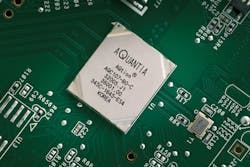Marvell Spends $450 Million to Expand Ethernet Chip Business
Marvell Semiconductor said it will pay $452 million to acquire Aquantia, moving it further into the market for Ethernet transceivers and controllers dropped in network infrastructure, data centers, factories, cars. The Santa Clara, California-based company said that the deal will broaden its Ethernet PHY and MAC product lines as it attempts to increase its overall networking sales.
Marvell sells Ethernet transceivers and controllers that touch top speeds of one gigabit-per-second (Gbps) over the copper cabling that connects the computers inside data centers, cars and network equipment, including 5G infrastructure. Its rivals range from Broadcom and Microchip to Texas Instruments and NXP Semiconductors. Aquantia is focused on offering Multi-Gig Ethernet chips based on 2.5G, 5G and 10G standards.
“The product lines of both companies are highly complementary,” Matt Murphy, the chief executive of Marvell, on an analyst conference call Monday. Marvell estimates that its Ethernet networking sales will increase around 8% per year through 2021. “We will have a comprehensive portfolio, and with our Ethernet switch and processor products, customers across the infrastructure market will benefit from a full Ethernet platform."
The deal demonstrates how aggressively Marvell is trying to bolster its business amid slowing growth, swelling costs and tightening competition. Last year, the company said that the $6 billion deal to buy Cavium had turned it into “an infrastructure solutions powerhouse." Murphy has also taken big steps to streamline the Santa Clara, California-based company, including trimming about 2,000 jobs and selling non-core businesses.
Marvell’s latest deal does more than expand its infrastructure solution business. It also strengthens the company’s position in the market for in-vehicle networking. Aquantia sells Ethernet chips that significantly speed up data transfers inside cars and support advanced driver assistance systems such as automatic emergency braking, electronic stability control and lane-keeping assistance—all of which demand instant communications.
Most modern cars use the Controller Area Network (CAN) bus to coordinate ECUs that need to trade engine, powertrain, and diagnostic data, transmitting details like transmission status and fluid levels. Additional local interconnection networks, or LINs, handle communications for cheaper, less critical functions, like window and seat controls. The Ethernet networks used in cars today range roughly from 100 Mbps to 1 Gbps.
But that will not be fast enough for autonomous cars, which will have to make split second driving decisions. Any communications network also has to handle the torrent of information generated by the car’s cameras, radars and other sensors—more than a gigabit every second of driving. That includes live data about road conditions, weather, traffic, street signs and its surroundings, all of which needs to be shared between the ECUs.
Aquantia has started selling Ethernet PHYs and MACs for cars with speeds ranging from 2.5 Gbps to 10 Gbps. One of its biggest customers is Nvidia, which uses Multi-Gig Automotive Ethernet in its Pegasus supercomputer for autonomous driving. The challenge for Aquantia is to enable fast data transfers while offering resistance to high temperatures, violent vibrations, and other signal-scrambling interference.
Other companies are racing to bring high-speed internal networks to cars. Valens Semiconductor sells chips that can transfer audio, video, power, Ethernet and other signals over an unshielded copper cable. Broadcom, the biggest supplier of chips used in data center switches, and NXP, the market share leader in automotive chips, are also trying to muscle into the market. There is a potential windfall for whoever wins.
Aquantia estimates that an average autonomous car will use around 50 networking components—more than necessary but important for ensuring redundancy. As more in-vehicle networks move to Ethernet, the number of Ethernet ports installed in cars globally is projected to grow from 53 million units in 2018 to to 367 million by 2022, according to Strategy Analytics. That represents an average annual growth rate of more than 60%.
Under the terms of the deal, Marvell has agreed to pay Aquantia’s shareholders $13.25 per share. The company said the deal will close before the end of the year after Aquantia’s shareholders approve it. “Aquantia extends our reach in the rapidly emerging Multi-Gig segment of network infrastructure and creates a leading end-to-end Ethernet connectivity portfolio,” Murphy, Marvell’s chief executive, said in a statement.
About the Author
James Morra
Senior Editor
James Morra is the senior editor for Electronic Design, covering the semiconductor industry and new technology trends, with a focus on power electronics and power management. He also reports on the business behind electrical engineering, including the electronics supply chain. He joined Electronic Design in 2015 and is based in Chicago, Illinois.

